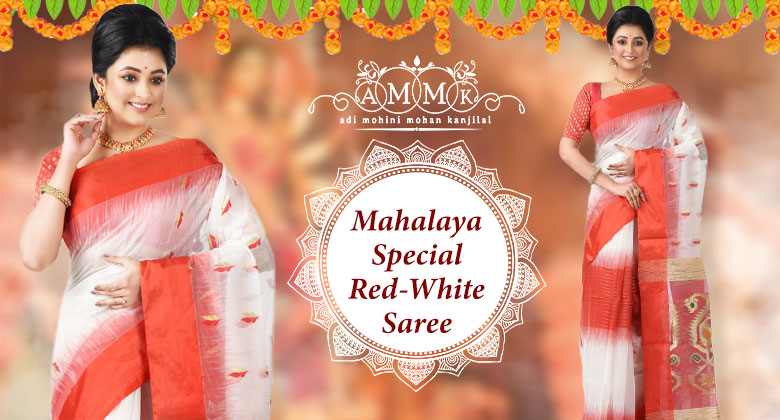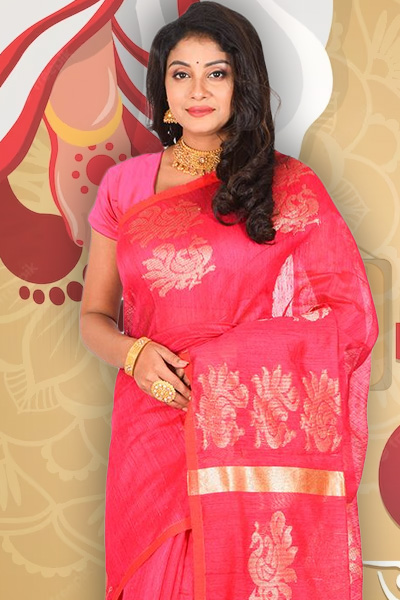
Exotic Red and White Saree to celebrate this Mahalaya in a traditional way
Mahalaya, which indicates the beginning of Devi-Paksha and the end of the Pitri-Paksha (the Shradh or the mourning period) is an auspicious day for Bengalis, who celebrate it with much devotion. Mahalaya is observed seven days before the Durga Puja.
This day also has a special meaning for all Hindus, who perform the ritual of Tarpan (offering). Men clad in dhotis go to the banks of the river Ganga to offer prayers to their deceased forefathers and perform pind-daan.
There are much folklore associated with the occasion amongst which the most famous is Mahalaya is an invitation to the Goddess Durga to begin her journey from Kailash to her paternal abode (earth), along with her children. This invitation is extended through the chanting of mantras and singing devotional songs (aagomoni gan) like Jago Tumi Jago and Bajlo Tomar Alor Benu.
The very famous Lal paar saree or simply the saree with a red border is a part of the life of Bengali women. Especially, when it is Mahalaya, it is an age-old tradition for Bengali women to wear a Lal par saree with much love and grandeur. It is because red and white sarees are considered very auspicious. In a lal paar saree, White stands for purity while red symbolizes fertility.
There are a variety of red and white sarees like tussar, jamdani, tant, garad and garad-Korial, muslin, Korial-Banarasi and so on.
Tussar silk:
Tussar silk is also known as Tassar or wild silk which is collected from forest silkworm when cocoons are dried under the sun. Tussar silk is very famous for its natural Gold color. Tussar silk is basically used in the creation of tussar silk sarees. The off gold texture and wave works is suitable for embroideries as well as print motifs which have been inspired by nature. The flower design and the shape of leaves and leaflets, buds, bels, trees are a source of inspiration for tussar silk.Plain tussar silk saree with a red border is another chosen saree for Bengali women on Mahalaya.
Jamdani:
One of the varieties of the finest muslin, figured or flowered, Jamdani is a woven fabric in cotton. Jamdani originated from Bangladesh said to be patronized by royal families of the Mughal emperors. It is said to be the most artistic creation of Bangladeshi weavers.

It is a supplementary weft technique, where the artistic motifs are produced by a non-structural weft, in addition to the standard weft that holds the warp threads together. The standard weft creates a fine fabric while the supplementary weft with thicker threads adds the intricate designs to it. Each supplementary weft motif is added separately by hand The result is a combination of vibrant patterns that appear to float on a shimmering surface. Interestingly, the pattern is drawn on a graph paper and placed underneath the warp. The fine muslin jamdani is often a mixture of cotton and gold thread. This is appreciated as traditional wear of Mahalaya. Red border with white base jamdani saree is always there in Durga puja collection of a Bengali lady.
Tant:
The famous tant sarees of West Bengal are usually woven in variety of paisley, floral and other artistic motifs. Tant saree in red and white combination is the most ethnic attire for women of Bengal at the day of Mahalaya followed by Durga puja.
Garad and Garad Korial:
The famous Garad silk saree represents serenity and purity in its simple red border and a striped pallav with a plain white silk base. Garad means white and gets its name from the mulberry silk threads. Sarees that are woven with this thread is not dyed and therefore it is pure. Because of this purity, cloth has made the best choice for the events of puja. This type of saree is mostly in white base with a red border and Bengali woman love to wear Garad silk saree during the auspicious day of Mahalaya.

Muslin Dhakai:
The muslin sarees are an exotic version of jamdani sarees originated from Bangladesh and it is very popular in West Bengal. Muslin jamdani saree is lightweight, transparent and with hand thread work of floral and geometric design. This is a festive saree and since Mahalaya is the first day of the biggest festival of Bengal, the craving for this saree is at its highest level during this time.
Korial-Banarasi: Korial Banarasi sarees
It has an off-white base with jari work all over the body that are the specialty of banarasi silk and furnishes with red border and pallav of the sarees. This is exactly the saree, the ladies of Bengal looks for on Mahalaya day at the festive of Durga puja.
Baluchari:
The fusion of baluchari silk saree in red and white looks very elegant. It is a handwoven saree and using exquisitely dyed silk, with gold zari and intricate designs picturizing Indian mythology woven on its large ‘pallu'.

Mahalaya marks the start of the Durga Puja festival. On this day, the goddess Durga is believed to have descended to Earth. Mahalaya is marked by large, elaborately crafted statutes of Durga which are set up in homes and on decorated podiums called Pandals. You can wear any of the above mentioned exotic white saree with red border while taking an active part in this festival of Mahalaya.
